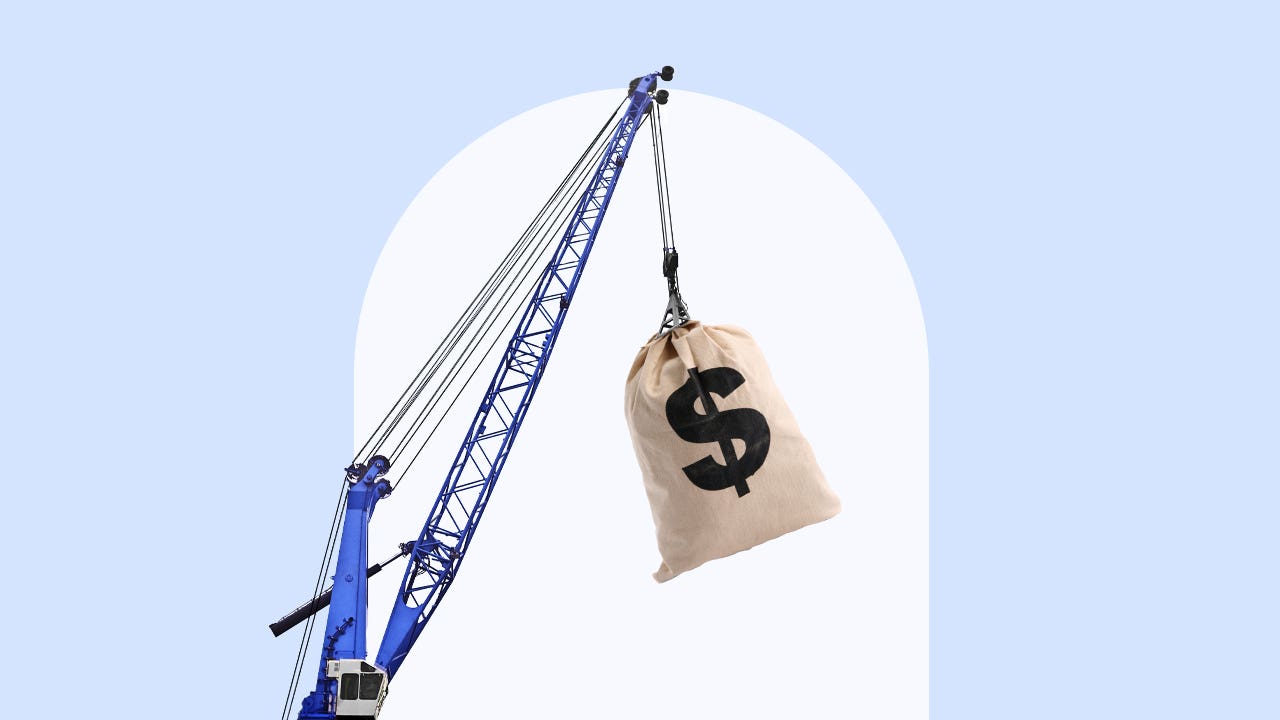What are construction loans?

The Bankrate promise
At Bankrate we strive to help you make smarter financial decisions. While we adhere to strict , this post may contain references to products from our partners. Here's an explanation for .
Key takeaways
- Construction loans are short-term loans that you can use to build a home.
- Some construction loans can be converted to mortgages after your home is finished.
- Construction loans typically have tougher criteria and higher interest rates than conventional mortgages for existing homes.
If you can’t find the right home to buy, you might be thinking about building a house instead. Financing this type of project is somewhat different than borrowing funds to buy an existing property, however. Instead of a mortgage, you take on a construction loan (also known as a construction mortgage). Here’s what to know about construction loans.
What are construction loans?
Construction loans are loans that fund the building of a residential home (aka a stick-built house), from the land purchase to the finished structure. Common types are a standalone construction loan — a short-term loan (generally with a year-long term) — which only finances the building phase, and a construction-to-permanent loan, which converts into a mortgage once the construction is done. Borrowers who take out a standalone construction loan often get a separate mortgage to pay it off when the principal falls due.
What costs are covered by a construction loan?
You can use a construction loan to cover such costs as:
- The land/lot
- Contractor labor
- Building materials
- Permits
As the name implies, construction loans cover the costs of building a home. Typically, that means the expenses associated with construction, such as contractor fees, labor and permits. But you can also use the funds to purchase the land or property lot itself.
However, construction loans do not include design costs. If you want to hire a professional architect or interior designer, you’ll need to cover that cost on your own.
How do construction loans work?
The initial term on a construction loan generally lasts a year or less, during which time you must finish the project. Because construction loans work on such a short timetable and are dependent on the project’s progress, you (or your general contractor) must provide the lender with a construction timeline, detailed plans and a realistic budget. Based on that, the lender will release funds at various phases of the project, usually directly to the contractor.
- Construction loans typically require 20 percent down, at minimum.
- As of February 2024, construction loan origination volume totaled $489.62 billion, according to the Federal Deposit Insurance Corporation.
- As of Q4 2023, the top five construction loan lenders, in terms of number of loans, are (in order): Wells Fargo, JP Morgan Chase, Bank of America, Bank OZK and U.S. Bank.
Construction loans vs. traditional mortgages
Beyond the cost and repayment timeline, construction loans and mortgages have a few main differences:
- The funds distribution: Unlike mortgages and home equity loans, which provide funds in a lump-sum payment, the lender pays out the money for a construction loan in stages as work on the new home progresses. These draws tend to happen when major milestones are completed — for example, when the foundation is laid or the framing of the house begins.
- The repayments: With a mortgage, you start paying back the principal and interest right away. With construction loans, your lender will typically expect you just to make interest payments during the construction stage. Additionally, borrowers are only obligated to repay interest on actual funds drawn to date until construction is completed.
- Inspection/appraiser involvement: While the home is being built, the lender has an appraiser or inspector check the house during the various construction stages. As the work is approved, the lender makes additional payments to the contractor, known as draws. Expect to have between four and six inspections to monitor the progress.
- Requirements: As with mortgages, construction loan borrowers need to be financially stable and able to make a down payment. But since there’s no property to appraise, lenders also want to see a construction plan, a detailed outline of the project, in deciding how much to give you.
- Interest rates: Construction loan interest rates are typically higher than traditional mortgage rates. The reason: There’s no existing structure to provide collateral to back the loan. That means the lender is taking on more risk.
Types of construction loans
Different construction loan types are available to borrowers and are designed to suit various financial needs.
Construction-to-permanent loan
With a construction-to-permanent loan, once the house is complete and you move in, the loan morphs into a traditional mortgage. Typically, you can choose your term of 15 to 30 years, and you can opt for a fixed rate or an adjustable rate.
During the construction-loan phase, you’re only responsible for interest payments on the money drawn, as it’s drawn. After the conversion, you start making payments that cover interest and the principal — as you would with any mortgage.
While many construction loans are conventional loans — entirely privately originated and financed — there are government versions as well. Your other options include an FHA construction-to-permanent loan — with less stringent approval standards that can be especially helpful for some borrowers — or a VA construction loan if you’re an eligible veteran.
Whatever the type, the big benefit of the construction-to-permanent approach is that you have only a single set of closing costs to pay, reducing your overall expenses. “There’s a one-time closing, so you don’t pay duplicate settlement fees,” says Janet Bossi, senior vice president at OceanFirst Bank in New Jersey.
Construction-only loan
A construction-only loan provides the funds necessary to build the home, but the borrower is responsible for repaying the loan in full at maturity (typically one year or less). You can settle the debt in cash or by obtaining a mortgage to pay it off.
The advantage of this approach: You might get better terms with the new mortgage (construction loans tend to be more expensive – see “Construction loan rates” below). Still, construction-only loans can ultimately be costlier than their construction-to-permanent cousins. That’s because you complete two separate loan transactions and pay two sets of closing costs (which tend to equal thousands of dollars). And, of course, you have to invest time and energy shopping for a mortgage.
Another consideration: If your financial situation worsens during the building, you might not be able to qualify for a mortgage later on — and might not be able to move into your new house.
Renovation loan
If you want to upgrade an existing home rather than build one, you can compare home renovation loan options. These come in a variety of forms depending on the amount of money you’re spending on the project.
“If a homeowner is looking to spend less than $20,000, they could consider getting a personal loan or using a credit card to finance the renovation,” says Steve Kaminski, head of U.S. Residential Lending at TD Bank. “For renovations starting at $25,000 or so, a home equity loan or line of credit may be appropriate if the homeowner has built up equity in their home.”
Another viable option in a low mortgage rate environment is a cash-out refinance, in which a homeowner takes out a new mortgage in a higher amount than their current loan, receiving the extra as a lump sum. As rates tick up, though, cash-out refis become less appealing.
With refis or home equity loans, the lender generally does not require disclosure of how the homeowner will use the funds. The homeowner manages the budget, the plan and the payments. With some renovation loans, the lender will evaluate the builder, review the budget and oversee the draw schedule.
Owner-builder construction loan
Owner-builder loans are construction-to-permanent or construction-only loans in which the borrower also acts in the capacity of the home builder.
Most lenders won’t allow the borrower to act as their own builder because of the complexity of constructing a home and the experience required to comply with building codes. Lenders typically only allow it if the borrower is a licensed builder by trade.
End loan
An end loan simply refers to the homeowner’s mortgage once the property is built, says Kaminski. You use a construction loan during the building phase and repay it once the construction is completed. You’ll then have a regular mortgage to pay off, also known as the end loan.
“Not all lenders offer a construction-to-permanent loan, which involves a single loan closing,” says Kaminski. “Some require a second closing to move into the permanent mortgage or an end loan.”
Construction loan rates
Unlike traditional mortgages, which carry fixed rates, construction loans usually have variable rates that fluctuate with the prime rate. That means your monthly payment can also change, moving upward or downward based on rate changes.
Construction loan rates are also typically higher than traditional mortgage rates. That’s partially because they’re unsecured (backed by an asset). With a traditional mortgage, your home acts as collateral — if you default on your payments, the lender can seize your home. With a home construction loan, the lender doesn’t have that option, so they tend to view these loans as bigger risks.
On average, you can expect interest rates for construction loans to be about 1 percentage point higher than those of traditional mortgage rates.
Construction loan requirements
The companies that offer construction loans usually require borrowers to:
- Be financially stable. To get a construction loan, you’ll need a low debt-to-income ratio and proof of sufficient income to repay the loan. You also generally need a credit score of at least 680.
- Make a down payment. You need to make a down payment when you apply for the loan, just as you do with most mortgages. The amount will depend on the lender you choose and the amount you’re trying to borrow to pay for construction, but construction loans usually require at least 20 percent down.
- Have a construction plan. Lenders will want you to work with a reputable construction company and architect to come up with a detailed plan and schedule.
- Get a home appraisal. Whether you’re getting a construction-only loan or a construction-to-permanent loan, lenders want to be certain that the home is (or will be) worth the money they’re lending you. The appraiser will assess the blueprints, the value of the lot and other details to arrive at an accurate figure. For construction-to-permanent loans, the home will serve as collateral for the mortgage once construction is complete.
How to get a construction loan
Getting approval for a construction loan might seem similar to the process of obtaining a mortgage, but getting approved to break ground on a brand-new home is a bit more complicated. Generally, you should follow these four steps:
- Find a licensed builder: Lenders will want to know that your chosen builder has the expertise to complete the home. If you have friends who have built their own homes, ask for recommendations. You can also turn to the NAHB’s directory of local home builders’ associations to find contractors in your area. Just as you would compare multiple existing homes before buying one, it’s wise to compare different builders to find the combination of price and expertise that fits your needs.
- Find a construction loan lender: Check with several experienced construction loan lenders to obtain details about their specific programs and procedures. If you have trouble finding a lender willing to work with you, check out smaller regional banks or credit unions. Compare construction loan rates, terms and down payment requirements to ensure you’re getting the best possible deal for your situation.
- Get your documents together: A lender will likely ask for a contract with your builder that includes detailed pricing and plans for the project. Be sure to have references for your builder and any necessary proof of their business credentials. You will also likely need to provide many of the same financial documents as you would for a traditional mortgage, like pay stubs and tax statements, that offer proof of income, assets and employment.
- Get preapproved: Getting preapproved for a construction loan can provide a helpful understanding of how much you will be able to borrow for the project. This can be an important step to avoid paying for plans from an architect or drawing up blueprints for a home that you will not be able to afford.
- Get homeowners insurance: Even though you may not live in the home yet, your lender will likely require a prepaid homeowners insurance policy that includes builder’s risk coverage. This way, if something happens during the construction process — the halfway-built property catches on fire or someone vandalizes it, for example — you are protected.
Construction loan FAQ
-
Ask your lender how money gets disbursed from your loan amount. Some lenders allow for monthly draws, while others will only authorize a draw after a passed inspection. Inquire about any processes or documentation required to pull money from your construction loan so that you can pay the bills in a timely fashion as they come in. Understanding this process — and ensuring your contractor does, too — can help to avoid delays because of insufficient funds.
-
There are benefits and drawbacks to construction loans. These types of loans tend to have higher interest rates than those associated with a mortgage, for instance. In addition, the funds provided by a construction loan are only released in stages as work on your home progresses rather than in a lump sum upfront. However, construction loans often only require interest payments while your home is being built, which can be easier on your budget. The loan terms may also be more flexible than those that come with a traditional loan.
-
Talk to your contractor and discuss the timeline of building the home and what sort of factors could slow down the job. Delays could result in changes to your loan’s interest rate, which can lead to higher payments. Delays can also lead to delays in fund disbursement for construction-only loans.If your project takes longer than expected, work with your contractor to try to resolve any bottlenecks. You should also keep in touch with your lender to let them know what’s going on.
-
In general, it is harder to qualify for a construction loan than for a traditional mortgage. Most lenders require a credit score of at least 680 — which is higher than what you’d need for most conventional VA and FHA loans. It’s also typical for lenders to ask for a minimum down payment of 20 percent on construction loans, so you may have trouble qualifying if you can’t get that much money together up front.
Additional reporting by Ashlee Tilford
Related Articles



Portfolio mortgage lenders: What are they and how do you find one?
